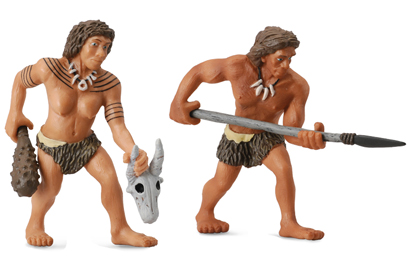Changing Perceptions Towards Homo neanderthalensis
The Gibraltar Museum is holding a special conference at the end of September. It is in part a celebration of the Museum’s eighty-five year history but it also sets out to re-dress some of the misconceptions about our nearest ancestor, the Neanderthal. The idea that these hominins were nothing more than blood-thirsty, brutal creatures, a view held as sacrosanct for much of the 20th century, has now been altered for ever as recent discoveries by palaeontologists and palaeoanthropologists have shed new light on our closest ancestor, one that walked amongst us as recently as 28,000 years ago.
Neanderthals
Neanderthal – Our Closest Relative
The models shown above are Neanderthal figures which are part of the CollectA Prehistoric World model range: CollectA Prehistoric Models and Figures.
High profile speakers and international scientists, all specialists in the study of human evolution, will converge on Gibraltar to discuss how our views have changed in a conference entitled “Redefining the Neanderthals”.
Evidence from Gibraltar
Gibraltar is a very appropriate location to hold such a conference. It was in Gibraltar that the first Neanderthal skull was found and studied by scientists, although the find (1848), took place before the Neanderthal species was named. Neanderthal occupation has been identified in at least ten caves in the area, in fact, the Neanderthals who lived on the coastal plain that once existed where the rock of Gibraltar now stands may have been some of the very last of their species.
The Neanderthal caves and the surrounding area has been nominated for World Heritage Status, if these locations are granted such status, it would give the caves the same standing in scientific circles as the Great Barrier Reef, and the Jurassic Coast of Dorset.
The conference will also highlight Gibraltar as an exceptionally important part of the world for Neanderthal studies. It will run from the 24th to 26th September and invited delegates will be given the opportunity to visit some of the research sites on Sunday the 27th. Professor Chris Stringer (Natural History Museum, London) will deliver the opening address. Speakers will come from a number of countries including Spain, Italy, Croatia, Germany and the United States.
A Wide Variety of Topics to Discuss
Topics to be discussed will include how the Neanderthals were able to exploit raptors and corvids (crows), for a number of purposes. For example, eagle talons have been used as jewellery (reported from Croatia earlier this summer).
The conference will provide a fresh insight into the Neanderthals, a sophisticated, perfectly adapted hominin whose extinction remains a mystery as there is a growing body of evidence to suggest that these people were smart, strong, capable of language and developed sophisticated cultures.
Why they are gone yet we are here is one of the questions likely to be debated.
If you don’t think the Neanderthals were smart, try catching a crow, or an eagle for that matter!
Visit Everything Dinosaur’s award-winning website: Everything Dinosaur.






